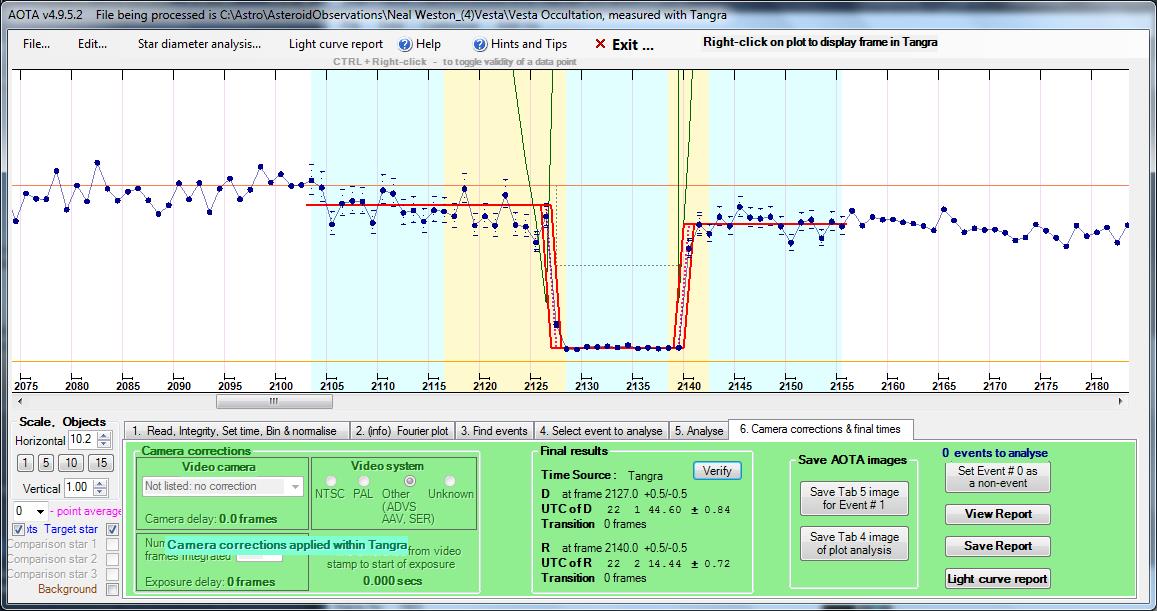(4)Vesta
occults HIP-14439 on 2020-Feb-11
at 2201-2203 UT
Results Summary:
Update: 2020 Feb 15:
Neal Weston of Aberdeen Astronomical Society (Scotland), observing near
Stonehaven, recorded a near central occultation of 29.8 +/- 1.6sec
He used a 120mm APO refractor and SX Trius694 CCD, recording 1000 FITS
frames of exposure 0.5s, and delay between exposure of 1.0sec. The frames
were processed by the BAA Asteroids and Remote Planets Section to produce
this light curve: The result is published on EURASTER http://www.euraster.net/results/2020/index.html#0211-4
created: 2019 Nov 23
Introduction
There is an opportunity to see a binocular visible star being occulted
by a large asteroid: (4) Vesta.
This type of event - one involving a bright star and large asteroid - is quite an infrequent occurrence [ see Note-1]. Something like one prediction in twenty years, where the event is potentially visible from parts of the UK. Usually a small telescope is needed or perhaps the unaided eye if clear and dark enough. Once the star is located, one needs to watch for about 2 min from 2201 to 2203 Hrs. The star should disappear behind Vesta and then reappear up to 28sec later. The duration is dependent on where the observer is within the shadow path. (Could be a short duration of a few seconds if you are near the edge of the path).
In a telescope it should also be possible to watch Vesta approach and then occult the star. [ See further on, how-to-find the star ]. This is interesting in itself, and one should commence observation 30min or 1 hr before, to watch Vesta move gradually towards the occulted star.
The approach or "appulse" can be seen from anywhere in the UK, but the actual occultation is predicted for N Ireland, Isle of Man, Northern England, Scotland and Northern Europe. The information panel (below) show the shadow limits in yellow and a schematic outline of Vesta in white as it crosses our line of sight. You wont see the shape of Vesta, only the disappearance and reappearance (D-R) of the star, which if timed accurately (+/- 0.3sec), is a useful observation.
Please be aware, that predictions have errors, however the certainty of this event near the centre of the the shadow is expected to be close to 100%. (Weather permitting)
About (4) Vesta
Vesta is the fourth member of the "asteroid belt" to be discovered. That was in 1807 by Heinrich Olbers. Vesta has an irregular cratered outline. Asteroids range in size from a few meters up to about 500Km. Vesta has a diameter of 525 Km.
It was Olbers who proposed that a belt of material existed between Mars and Jupiter where he suggested there were the remains of a destroyed planet. The largest "fragments" are compared in this wiki. One slide is reproduced here:
Amateur and professional astronomers use the star occultation technique to measure the shape of asteroids with sizes 20 km and larger.
How-to-find-the-star
You will need to face SW.
The occultation or close appulse is at 2202Hrs, above the horizon at
Altitude +27 and Azimuth 254 (i.e. compass bearing 254). The Moon will
have risen in the East so the sky will be brightening. It's recommended
to set up at 2100Hrs and watch the event unfold. Dress for cold conditions
and put a long dew cap on your telescope lens to stop it dewing over.
There will be detailed
maps at Steve Preston's web page
http://www.asteroidoccultations.com/2020_02/0211_4_64136.htm when
the path is updated.
Here I show some maps (1
and 2).
1) Horizon view SW.
The small white square is a 10 degree area, a bit larger than low magnification
binoculars.
2)
An area of sky about 7 x10 deg wide.
4-Vesta is superimposed on the occulted star plotted in orange. The
star is HIP14439 (Hipparcos
catalogue)
The occulted star is also know as: SAO 93276, TYC 654-1754-1, and HD19270.
If you have a goto telescope with a hand set, the SAO catalogue may
be the one to use, otherwise star-hop from a recognisable star pattern.
Watch this star.
What
to report
Please send us a report if you observed or timed the D-R
Your
name / Your astro group
E-mail
Location.
What you saw / type of telescope used.
If
you timed the event and have UT of start / end / duration, we will send
you a report form to collect these details. Contact
occultations@stargazer.me.uk. or the Director
of the BAA Asteroids
and Remote Planets Section.
[ Note-1] There is an observing program organised by the Intenational Occultation Timeing Association (IOTA-ES), where observers regularly record smaller asteroids occulting fainter stars. These predictions are issued monthly and there is at least one prediction per week that can be observed. The shadow paths over Europe will involve many observers, and the results can be remarkable. See the EURASTER.NET web pages. More observers are welcomed.
Possible
the best recent example of the use of the occulation method, was the
size determination of MU69 prior to the the New Horizons Encounter.
https://www.nasa.gov/feature/nasa-s-new-horizons-team-strikes-gold-in-argentina
The observing team used SkyWatcher
Dobsonian telescopes with a QHY 174m GPS camera to record the star.
About occultations and this page:
This is a personal web page to support occultation observers. There
is a discussion group: https://groups.io/g/UKoccultations
which observers are welcome to join. An observation sent to the writer
or the BAA is a preliminary analysis prior to submission to IOTA-ES
and collaborators.
Acknowledgements:
Edwin Goffin (Hoboken, Belgium) for the prediction.
Dave Herald (Murrumbatetman, Australia) for the prediction software
Occult4
SkyMap pro 11 was used to present the path on the sky and the star fields.
Steve Preston for asteroidoccultation details and updates.
